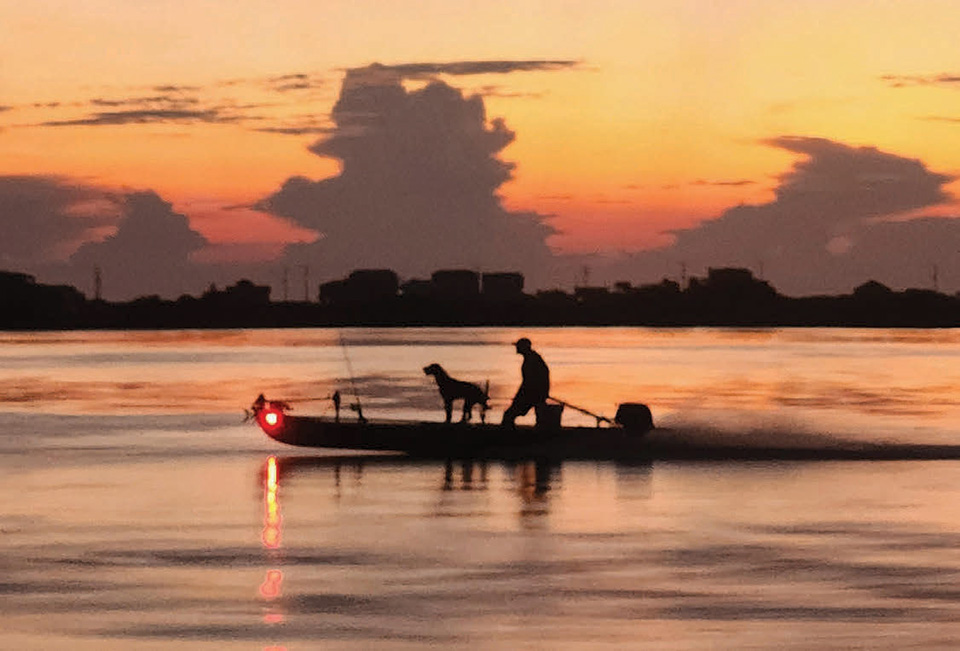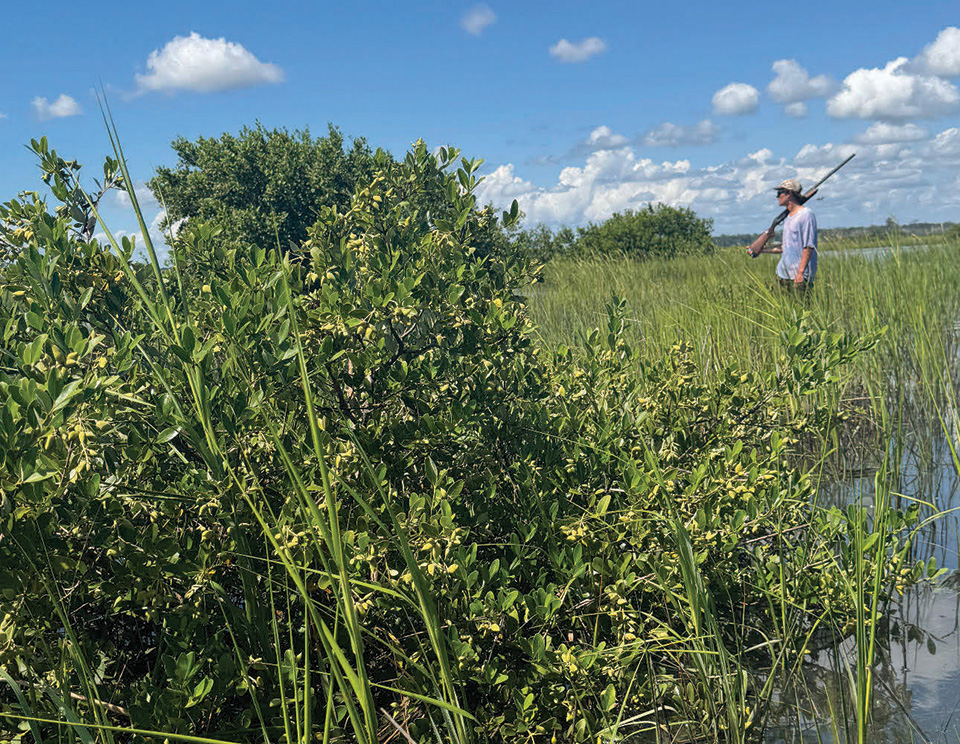By Alex Womack
When the moon is full and the king tides of the fall run high, the spartina grass will flood on Florida’s First Coast. The high water in the marsh allows redfish to access flats that are rarely under water. This phenomenon has a positive effect, providing the reds new real estate to hunt in and added items to their menu. This same flood tide that covers our tall grass and mangrove trees has a directly inverse effect on birds of the marsh such as the Clapper Rail, better known as the Marsh Hen. The high tide reduces most of their cover that they use to hide in when it floods. The result is a concentration of the birds that makes them possible to hunt effectively and kicks off a seasonal southern tradition as well.
When to Go
In Northeast Florida, we enjoy a substantial tidal swing that averages a healthy 4-6 feet each switch four times a day, every day. Additionally, in the late summer and fall we have what are known as King Tides or flood tides. These periodical swings fluctuate depending on a combination of critical conditions and create these abnormally high tides. This large differential can be a blessing, a curse, and an inevitable learning curve for anyone navigating our NE Florida coastal waters. Marsh Hen season begins on the first day of September and ends on the ninth of November. It all starts with reading the tide chart. These tides are an abnormal phenomenon but seasonally they are extremely predictable-if that makes sense. These are the highest tides we see all year and can vary but they come around this same time of year annually. In addition, a full or new moon will push the tide anywhere from 1-3 extra feet above our normal levels. Ideally you will want your tide prediction to read well over 5 and a half feet (5.5) as on good days it will call for over 6 feet of high water, creating a truly proper fishing or hunting flood tide.Pay attention to the wind as well. Here in our area, moderate to strong NE winds are common, especially in this season and are partially responsible for adding to the higher water levels. Educate yourself on the charts and numbers you find on most marine forecast sites or tide and weather apps. Knowing these numbers will save you time, headaches from wasted days, and keep you safe.
What to Bring
Bring a gun that doesn’t mean the world to you because it will get wet, saltwater wet. I use a 20 GA Stoeger M3020 coated with camouflage cerakote. It is lightweight to carry on the bow all day and the smaller gauge helps to not ruin the meat that we are after on these smaller birds. It has been a great gun, and it’s not pricey nor is it sentimental which is perfect for the tough conditions we put it through hunting in the salt marsh.
Be sure not to forget at least one rod equipped with a light top water, plastic, or fly for when you see one of those tails for the first time that day. One local secret and long-time favorite bait is a weedless top water bass frog. Talk about a fun bite. The visual nature of flood tide sight fishing makes it more like hunting. When the tide floods, anything can happen. Persistence pays off and if you are out there long enough, it will happen. You will want an old pair of tennis shoes, boots, or anything you can tie on tight and keep on. You do not want to get in the waters of the salt marsh with out a good pair of tied up tight tennis shoes or durable bottom wading shoes that won’t come off to avoid life changing shellfish lacerations that are undoubtedly lurking in the murk below.
The Hunt
It is best to get where you want to start hunting by riding the last hour or so of the incoming high tide on your way back into the creek. This way allows the boat to be easily poled with the tide back into the flooded grass, hunting and looking for redfish tails on your way in. You will find that this technique works both ways. You can pole the slack-highest peak of the tide as far back into the flooded stuff as you can get and lastly ride the outgoing tide while easily poling yourself out for the day. Hunting waterfowl while under power (motor & trolling motor included) is illegal. For this reason, one will want to use the “with the tide” technique for more e&cient area coverage. Smarter not harder, you know the saying.
If you are not seeing the birds move as much as expected, the mystery of their whereabouts will be solved every time they cackle and crack in the creeks when they’re responding to each other. It is a beautiful sound.A sound that can spread for miles across the marsh as they sound off together. Slow down and listen. Hear the clapping—find the rails.They will file out of the taller grass, running across floating grass mats and swimming across small creeks between high points of the flat looking for cover. They jump and flush at the sound of a hull approaching their dead grass island or mangrove home as the boat is poled over the snail lined spartina grass. When you do eventually begin shooting at these flighty targets, pay attention for follow up shots on other birds spooked from the same area you just shot in. Also, the birds will disclose themselves and provide your direction for your next approach when they begin sounding off again after you shoot.
Safety First
Don’t be afraid to get up close and personal. The most fun and often most effective way you will find them will be jump shooting them as you pole along, so be ready. Be careful when you swing while aiming for the flighty targets, especially if you are in a 16 foot Gheenoe like us. A little communication will go a long way in keeping things safe. The shooting is quick, close, and can be surprisingly humbling. After a few misses an even half decent shot can usually figure it out and dial them in. When the birds start flying, things happen fast. A hen flushes left— a quick swing of the shotgun—a burst of brown feathers. Keep an eye on your bird as it hits the water. It can be easy to lose and hard to find these illusive birds, even if you think you smoked one—it is best to act fast and get em’ in the boat. Unless of course you are lucky to have a four-legged friend to help you find them. I love to bring Cash (my German short haired pointer) and after much hard-earned retrieve training, he has been great for a couple of years for hens and one duck season. By no means do you need a dog for this style of hunting, and I would venture to say that a good gun dog is unnecessary for most waterfowl hunting in Florida. Even with Cash boy on board for most of our hen hunts, he will only be sent on half of the birds on a “busy” day. Scooping them up with landing net as you pole by or hopping in yourself and being the worlds biggest bird dog are popular secondary options. Just remember, wear some form of a solidly strapped on full coverage shoe before getting in. Trust me. The marsh bottom that is not covered in oysters is soft and can be unforgiving. If you step in the wrong spot while wading around out there you can sink knee deep or worse into the “puff mud.” This nightmarishly soft sediment that we are plagued with here in our neck of the woods can prove to be a feat of physical strength if one wades into one of these unfortunate spots. So be mindful of your distance from the boat if you decide to wade and do not wade alone. This will not only make things safer but easier as well. I am a fan of both.
After the Hunt
As the tide turns and the water begins to fall, the birds melt back into the grass. On your way out of the creek, always keep your eyes peeled looking for a shot at a last-minute buzzer beater tailing redfish. It is time to head to the hill. I have never seen a boat dirtier than after a long hard marsh hen hunt. Time to clean the boat, the guns, the dog, and start dressing our birds.Hunters can keep no more than 15 birds per person and up to 45 birds as the total possession limit for the boat. When cleaning your marsh harvest, don’t just go for the breasts and forget the legs! If you are not keeping them whole, like a miniature Cornish game hen, for just a few extra seconds you can get them breasted out and have the legs and thighs broken down as well. This way we also use every part of these birds while respecting every aspect of the animal. If you really want to go full circle back to nature, our Florida stone crab season begins on October 15th, and the scraps left over after dressing the birds can make for a half decent crab bait. Marsh hens make for more than fine table fare. Simply marinate your dressed birds in your favorite stuff and grill them up, you can’t go wrong..
Keep the Tradition Alive
I wrote this to be semi educational, mostly inspirational, and ultimately invitational. An open invite to get outside with friends or family and get on the water with one another. An invite to learn something new, do something you miss doing from your past, or a chance to teach a kid something they may fall in love with forever. Just like my family and I have. From the tidal creeks of Mayport, down through Palm Valley, and south past Matanzas —the beautiful expanses of our tidal salt marsh are waiting to be explored by you and yours. There are more and more of us hunting and fishing out there these days so please respect each other’s space, respect the marsh, and always practice safety when hunting on the water. Have fun, be safe, catch em up, and good hunting everyone.

